
Sciaenidae is a family of ray-finned fishes belonging to the order Acanthuriformes. They are commonly called drums or croakers in reference to the repetitive throbbing or drumming sounds they make. The family consists of about 293 to 298 species in about 66 or 67 genera.

Micropogonias is a genus of marine ray-finned fishes belonging to the family Sciaenidae, the drums and croakers. These fishes are found in the eastern Pacific and western Atlantic Oceans.

Plagioscion is a genus of freshwater ray-finned fishes belonging to the family Sciaenidae, the drums and croakers. They are found in tropical and subtropical South America where they inhabit fresh and brackish waters. Some species are important food fish and support major fisheries.

Cynoscion is a genus of marine ray-finned fishes belonging to the family, Sciaenidae, the drums and croakers. These fishes are found off the coasts of North and South America in the western Atlantic and eastern Pacific Oceans. Many fishes in this genus have been given the common name weakfish.

The jack-knifefish is a species of marine ray-finned fish belonging to the family Sciaenidae, the drums and croakers. It is native to the western Atlantic Ocean, where its distribution extends along the eastern coasts of the Americas from the Carolinas in the United States to Brazil, including the Caribbean. Other common names include donkey fish and lance-shaped ribbonfish.
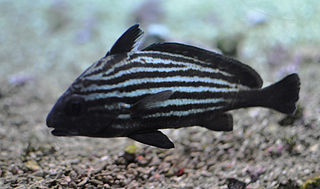
Pareques acuminatus, commonly known as the high-hat, donkeyfish, cubbyu, Steindachner's ribbonfish, streaked ribbonfish, striped ribbonfish or striped drum, is a species of marine ray-finned fish belonging to the genus Pareques in the family Sciaenidae, the drums and croakers. This species is found in the western Atlantic Ocean.

Larimichthys is a genus of marine ray-finned fishes belonging to the family Sciaenidae, the drums and croakers. These fishes, commonly known as yellow croakers, are found in the Western Pacific Ocean.

Panna is a genus of marine ray-finned fish belonging to the family Sciaenidae, the drums and croakers. These fishes are found in southern and southeast Asia.

Corvula is a genus of marine ray-finned fishes belonging to the family Sciaenidae, the drums and croakers. These fishes are found in the western Atlantic Ocean and the central eastern Pacific Ocean.

Bairdiella is a genus of marine ray-finned fishes belonging to the family Sciaenidae, the drums and croakers. These fishes are found in the western Atlantic and eastern Pacific Ocean.
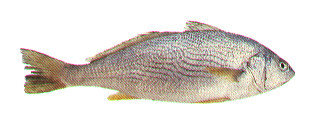
Umbrina is a genus of fish from the croaker family Sciaenidae. The genus contains 17 species occurring in tropical and warm temperate waters of the Atlantic, the Mediterranean, the Western Indian Ocean and the eastern Pacific.

Pareques is a genus of marine ray-finned fishes belonging to the family Sciaenidae, the drums and croakers. These fishes are found in the western Atlantic Ocean and eastern Pacific Ocean.

Lonchurus is a genus of marine ray-finned fishes belonging to the family Sciaenidae, the drums and croakers. These fishes are found in the Western Atlantic.
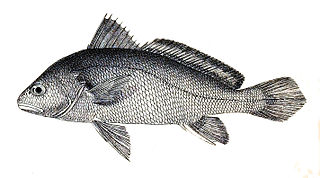
Nibea is a genus of marine ray-finned fishes belonging to the family Sciaenidae, the drums and croakers. The species in this genus are found in the Indo-West Pacific region.
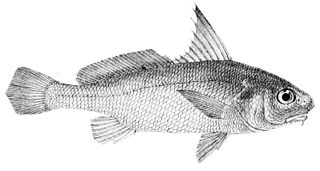
Johnius is a genus of marine ray-finned fishes belonging to the family Sciaenidae, the drums and croakers. They are commonly known as croakers due to their ability to produce purring, croaking and knocking sounds. The sounds are produced mainly at night and are thought to be either involved in defense or for courtship.

Macrodon is a genus of marine ray-finned fishes belonging to the family Sciaenidae, the drums and croakers. These fishes are found in the eastern Pacific and western Atlantic Oceans.

Odontoscion is a genus of marine ray-finned fish belonging to the family Sciaenidae, the croakers and drums. These fishes are found in the Western Atlantic and Eastern Pacific Oceans.
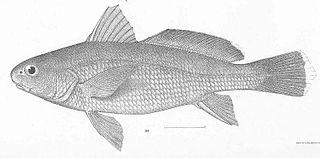
Ophioscion is a genus of marine ray-finned fishes belonging to the family Sciaenidae, the drums and croakers. These fishes are found in the Western Atlantic and Eastern Pacific Oceans.

Pachyurus is a genus of freshwater ray-finned fishes belonging to the family Sciaenidae, the drums and croakers. The ten recognised species in the genus are found in South America.
Paralonchurus is a genus of marine ray-finned fishes belonging to the family Sciaenidae, the drums and croakers. These fishes are found in the eastern Pacific Ocean with one species in the western Atlantic Ocean.

















